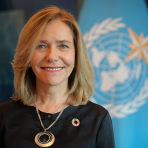Keynote Speech - High-level opening of the Ministerial event
Honorable Officials, Distinguished Guests, and Colleagues,
First of all, I would like to extend my warmest congratulations to Minister Bojan KUMER for organising this meeting and for hosting an exceptional dinner yesterday. Both the extraordinary building and the exquisite food made us all feel the warmth and hospitality of Slovenia.
It is a privilege to be here today to discuss matters that affect us all—climate change, environmental protection, and the role of meteorology and hydrology in shaping our response.
Slovenia, our host, with its rich biodiversity, pristine landscapes, and commitment to sustainability, is a vital player in meeting the global challenges.
We are all witnessing rising global temperatures, more extreme weather and growing pressure on ecosystems and natural resources.
The year 2024 was the hottest year on record, at about 1.55°C above the pre-industrial era. It was the warmest year on record for Europe. Unfortunately, Europe has been warming twice as fast as the global average. The forthcoming State of the Climate in Europe 2024 report, produced jointly by the Copernicus Climate Change Service and WMO –with all the valuable information provided by your respective met agencies- will provide more detail about this extraordinary year.
South-East Europe is among the most climate-vulnerable regions in Europe. Additionally, coastal areas, including the Adriatic coast, are increasingly at risk due to rising sea levels, leading to greater threats of flooding and infrastructure damage. Marine ecosystems are being harmed by ocean warming and marine heatwaves.
The frequency and severity of extreme weather events in South-Eastern Europe have intensified. This is leading to significant socioeconomic and environmental consequences.
- In August 2023, Slovenia experienced its worst flooding on record, impacting 1.5 million people, displacing 8,000 people from their homes and causing loss of life. Torrential rainfall caused landslides and economic disruption last July. And we can all recall the terrible damage inflicted in a number of European countries from Storm Boris in September.
- As I’ve mentioned, Slovenia had its hottest summer on record in 2024. Extreme heat impacted health, agriculture, water supplies and energy. In 2023, 41% of Southern Europe endured strong to extreme heat stress. WMO is therefore a committed partner in responding to the UN Secretary-General's Call to Action on Extreme Heat.
- In both 2023 and 2024, wildfires caused loss of life and property. Although the causes of wildfires are manifold, we must prepare for an increase in fire weather.
Unfortunately, the abnormal is our new normal. This reality calls for urgent, science-driven action.
Slovenia’s leadership in green initiatives, from sustainable forestry to innovative climate adaptation strategies, is commendable. However, the challenges ahead require even stronger collaboration—between government institutions, scientific communities, and international partners.
At this critical moment, we commend the organizers and Slovenia authorities for this timely high level Ministerial meeting, which places the region at the forefront of climate action. Bringing together key stakeholders (key people)—including ministries, meteorological and hydrological services, and other relevant actors—this Conference exemplifies the kind of subregional collaboration that paves the way for concrete climate action. These efforts are vital to transforming knowledge into impact, ensuring that cooperation and shared expertise lead to real progress.
Meteorology plays a crucial role in this fight. Accurate forecasting, early warning systems, and climate modeling are essential tools for resilience and adaptation. We now have exciting new tools such as Artificial Intelligence and Machine Learning which have the potential to greatly improve forecasts.
However, in South-East Europe, many National Meteorological and Hydrological Services still lack enough resources to provide adequate observations, forecasts and warnings of hazardous events. Strengthening these capabilities will protect lives and livelihoods and enhance preparedness for future climate-related risks. It is our common challenge to bridge national capabilities, such as those provided by hydromet services, with policy making. Hydromet information becomes relevant ONLY when it is included into decision making and value cycles to increase productivity, effectiveness and efficiencies.
Given the transboundary nature of climate risks, enhanced regional collaboration and coordination is essential to strengthen climate adaptation, resilience, optimize resource management, and foster sustainable development.
In 2022 the UNSG launched the The Early Warnings for All (EW4ALL) initiative which underscores the importance of regionally integrated multi-hazard early warning systems for improved risk management, preparedness, and anticipatory action.
One important initiative in this regard is the development of South-East European Multi-Hazards Early Warning System. This system is operating in pilot mode, and we encourage countries to provide further support to make it fully operational. What we may consider a high cost now; I can assure you: the cost of inaction is much higher. And this cost is affordable if it is shared between countries.
We are committed to reducing loss and damage from climate-related disasters and contribute to a more resilient region.
By fostering stronger regional cooperation, SEE countries can leverage collective expertise, financial resources, and technological advancements to strengthen climate adaptation strategies and resilience. To achieve this, an enhanced dialogue between Ministers, Secretaries of State and hydromet agencies is, certainly, a unique opportunity.
National Meteorological and Hydrological Services play a pivotal role in developing early warning capacities, monitoring climate trends and extreme events. I urge all governments in the region to invest in these services to empower them to achieve their mandate of saving lives and livelihoods. This also means that you will be supporting key actors to address your national commitments in terms of Paris Agreement, Sendai Framework and Sustainable Development Goals.
I look forward to exchanging insights on how we can reinforce policies, share best practices, and accelerate solutions that align with Slovenia’s and other South-East European countries environmental commitments and global sustainability goals. Together, we can turn challenges into opportunities for a safer, greener, more resilient future.
Statement by


